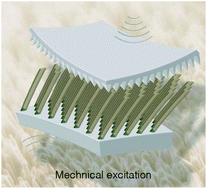Optimal geometrical design of inertial vibration DC piezoelectric nanogenerators based on obliquely aligned InN nanowire arrays†
Abstract
Piezoelectric nanogenerators have been investigated to generate electricity from environmental vibrations due to their energy conversion capabilities. In this study, we demonstrate an optimal geometrical design of inertial vibration direct-current piezoelectric nanogenerators based on obliquely aligned InN nanowire (NW) arrays with an optimized oblique angle of ∼58°, and driven by the inertial force of their own weight, using a mechanical shaker without any AC/DC converters. The nanogenerator device manifests potential applications not only as a unique energy harvesting device capable of scavenging energy from weak mechanical vibrations, but also as a sensitive strain sensor. The maximum output power density of the nanogenerator is estimated to be 2.9 nW cm−2, leading to an improvement of about 3–12 times that of vertically aligned ZnO NW DC nanogenerators. Integration of two nanogenerators also exhibits a linear increase in the output power, offering an enormous potential for the creation of self-powered sustainable nanosystems utilizing incessantly natural ambient energy sources.



 Please wait while we load your content...
Please wait while we load your content...